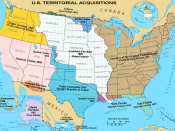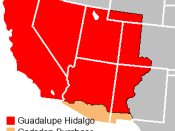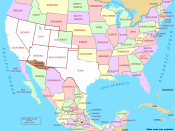In the years between 1830 and 1860, the United States grew economically, socially, and most noticeably, geographically. In this time period, Texas, Oregon, California, New Mexico, and Arizona were gained, completing the continental United States. Many Americans in the 19th century believed this acquisition of territory was a manifest destiny, or event accepted as inevitable. They thought it was the destiny of the U.S. to control all land from the east coast to the west coast. However, I believe that this land was taken as an act of aggressive imperialism on the part of the United States. Imperialism is the practice of extending the power and dominion of a nation by direct territorial acquisitions of other areas, and clearly America took much of this land by force rather than negotiation with other nations. The motives of the United States was not that of expansion, but in hopes of gaining new resources, land for agriculture, and natural resources.
Also, the gain of this territory was far from inevitable.
During the 19th century, the United States engaged in conflicts with both Great Britain and Mexico with victories yielding land. Although the boundary between Maine and Canada was determined by the Webster-Ashburn Treaty, the "battle of the maps" between Americans and British spurred negotiations. The southern border of Texas was set at the Rio Grande River following a three year war with Mexico, also resulting in the acquisition of the Mexican cession (California and New Mexico). The terms of the Treaty of Guadalupe-Hidalgo called for the United States to pay Mexico $15 million for this land, but this payment was more of a compensation for the war rather than purchase of land. The United States used force to gain much of the western territory, just as imperialist nations did overseas. I see no...


